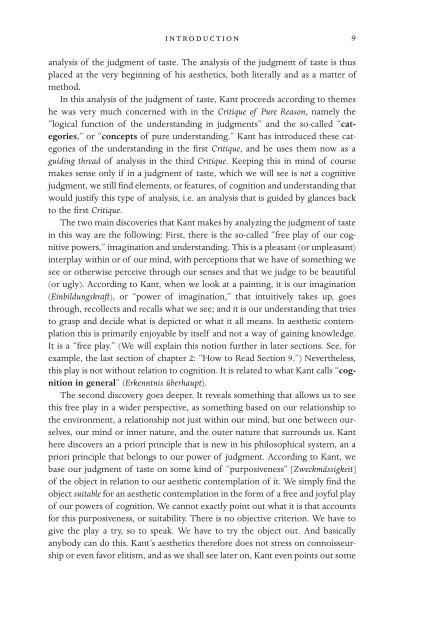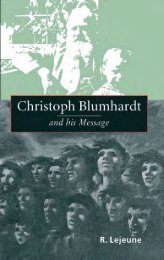AN INTRODUCTION TO KANT'S AESTHETICS
AN INTRODUCTION TO KANT'S AESTHETICS
AN INTRODUCTION TO KANT'S AESTHETICS
Create successful ePaper yourself
Turn your PDF publications into a flip-book with our unique Google optimized e-Paper software.
<strong>INTRODUCTION</strong> 9<br />
analysis of the judgment of taste. The analysis of the judgment of taste is thus<br />
placed at the very beginning of his aesthetics, both literally and as a matter of<br />
method.<br />
In this analysis of the judgment of taste, Kant proceeds according to themes<br />
he was very much concerned with in the Critique of Pure Reason, namely the<br />
“logical function of the understanding in judgments” and the so-called “categories,”<br />
or “concepts of pure understanding.” Kant has introduced these categories<br />
of the understanding in the first Critique, and he uses them now as a<br />
guiding thread of analysis in the third Critique. Keeping this in mind of course<br />
makes sense only if in a judgment of taste, which we will see is not a cognitive<br />
judgment, we still find elements, or features, of cognition and understanding that<br />
would justify this type of analysis, i.e. an analysis that is guided by glances back<br />
to the first Critique.<br />
The two main discoveries that Kant makes by analyzing the judgment of taste<br />
in this way are the following: First, there is the so-called “free play of our cognitive<br />
powers,” imagination and understanding. This is a pleasant (or unpleasant)<br />
interplay within or of our mind, with perceptions that we have of something we<br />
see or otherwise perceive through our senses and that we judge to be beautiful<br />
(or ugly). According to Kant, when we look at a painting, it is our imagination<br />
(Einbildungskraft), or “power of imagination,” that intuitively takes up, goes<br />
through, recollects and recalls what we see; and it is our understanding that tries<br />
to grasp and decide what is depicted or what it all means. In aesthetic contemplation<br />
this is primarily enjoyable by itself and not a way of gaining knowledge.<br />
It is a “free play.” (We will explain this notion further in later sections. See, for<br />
example, the last section of chapter 2: “How to Read Section 9.”) Nevertheless,<br />
this play is not without relation to cognition. It is related to what Kant calls “cognition<br />
in general” (Erkenntnis überhaupt).<br />
The second discovery goes deeper. It reveals something that allows us to see<br />
this free play in a wider perspective, as something based on our relationship to<br />
the environment, a relationship not just within our mind, but one between ourselves,<br />
our mind or inner nature, and the outer nature that surrounds us. Kant<br />
here discovers an a priori principle that is new in his philosophical system, an a<br />
priori principle that belongs to our power of judgment. According to Kant, we<br />
base our judgment of taste on some kind of “purposiveness” [Zweckmässigkeit]<br />
of the object in relation to our aesthetic contemplation of it. We simply find the<br />
object suitable for an aesthetic contemplation in the form of a free and joyful play<br />
of our powers of cognition. We cannot exactly point out what it is that accounts<br />
for this purposiveness, or suitability. There is no objective criterion. We have to<br />
give the play a try, so to speak. We have to try the object out. And basically<br />
anybody can do this. Kant’s aesthetics therefore does not stress on connoisseurship<br />
or even favor elitism, and as we shall see later on, Kant even points out some



